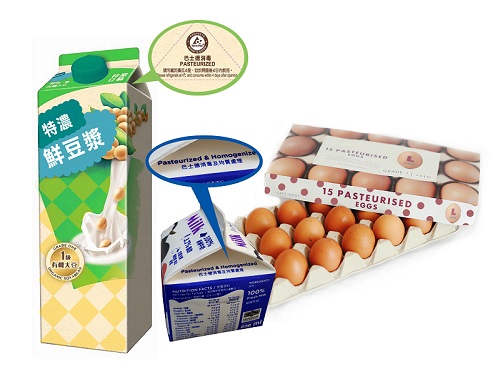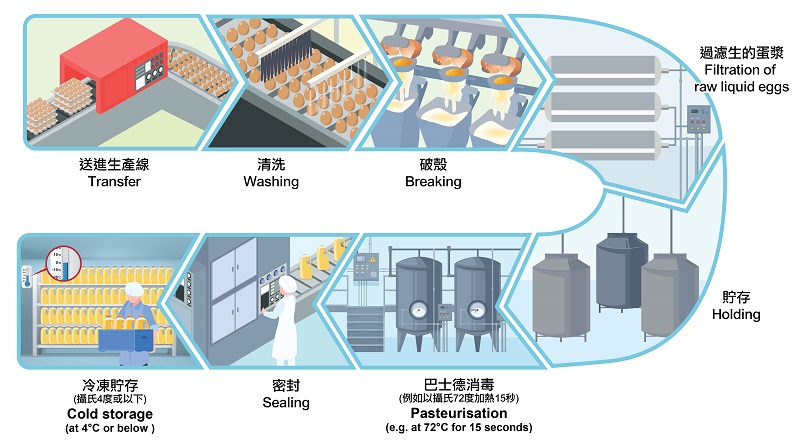
Food Safety Focus (192nd Issue, July 2022) – Article 2
Pasteurisation and Food Safety
Reported by Mr. Kenneth YIP, Scientific Officer,
Risk Communication Section, Centre for Food Safety
What is Pasteurisation?
Pasteurisation, along with canning and freezing, is a common technique of food preservation for perishable foods such as milk, eggs and juices. It is a heat treatment process that aims at reducing the number of pathogenic micro organisms to a level at which they do not constitute a significant health hazard. Pasteurisation helps maintain the desirable texture of food products, such as tiramisu and soft-scrambled eggs. This article will elaborate pasteurisation with examples of pasteurised food products, and suggest ways of handling pasteurised foods safely.
Pasteurisation involves heating food to a specific temperature for a set period of time. It is named after scientist Louis Pasteur, who proved in the 1860s that heating wine and beer for a few minutes would prevent spoilage. Pasteurisation aims at extending the shelf-life of food by inactivating non-spore-forming pathogenic bacteria and vegetative cells of spoilage microorganisms, as well as inhibiting enzyme activity.

Figure 2: Pasteurised food products commonly available on the market
Various processing time and temperature combinations can be applied for pasteurisation. Raw milk, for example, can be pasteurised by heating at 63°C for 30 minutes, or at a higher temperature of 72°C for 15 seconds, and then immediately cooling it to a temperature of not more than 10°C. Pasteurisation systems are developed to achieve a 99.999% reduction of the microbial load by using the most heat-tolerant target pathogen Coxiella burnetii. The higher temperature is applied, the shorter the heat treatment time is required. The pasteurisation time and temperature combinations used are designed for killing harmful bacteria such as Listeria, Salmonella, Campylobacter and Mycobacterium bovis, a common cause of tuberculosis before the widespread application of pasteurisation in commercial milk production. However, pasteurisation has its limitations. Some spore-forming bacteria like Bacillus may remain active after pasteurisation, which could lead to food spoilage or even food poisoning if the pasteurised food is stored under improper conditions.
As pasteurisation involves heat treatment, some may be concerned that such process would cause nutrient loss. Pasteurisation has different effects on various nutrients. Pasteurisation of milk, for example, is found to have little impact on minerals, fat composition and proteins. While pasteurisation has no impact on certain vitamins such as vitamin B1 and B6, it diminishes the amounts of those less heat-stable like vitamin C.
Pasteurised Ingredients are Safer for Dishes Without Thoroughly Cooked
While cooking food thoroughly is essential to eradicate foodborne pathogens, certain recipes may need food items to be treated with lower heat. When compared to their raw and untreated equivalents, pasteurised foods could be a safer option. It is because pasteurisation can reduce the amount of microorganisms in the food while maintaining its texture.
Pasteurised shell eggs, dried egg white powders and liquid eggs are examples of pasteurised egg products that may be used to prepare dishes that need to be made with lightly cooked eggs.

Figure 3: Production flow of pasteurised liquid eggs
Proper Handling of Pasteurised Food to Secure Food Safety
As pasteurisation does not kill all bacteria and cannot destroy spores that may germinate and cause food spoilage or food poisoning, proper storage of pasteurised foods is important. This is why pasteurised foods are typically kept in the fridges of grocery stores. To prevent bacterial growth, it is critical to follow the manufacturer’s instructions to store pasteurised foods, such as keeping pasteurised milk, soybean milk, juices and egg products refrigerated at or below 4°C. Check the expiry dates of pasteurised products before use. Once opened, use the pasteurised products as soon as possible.


